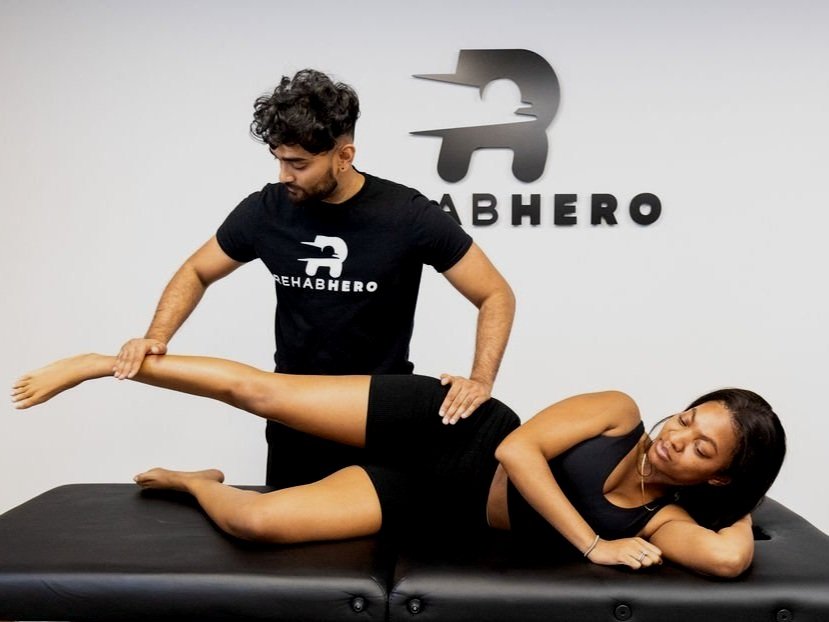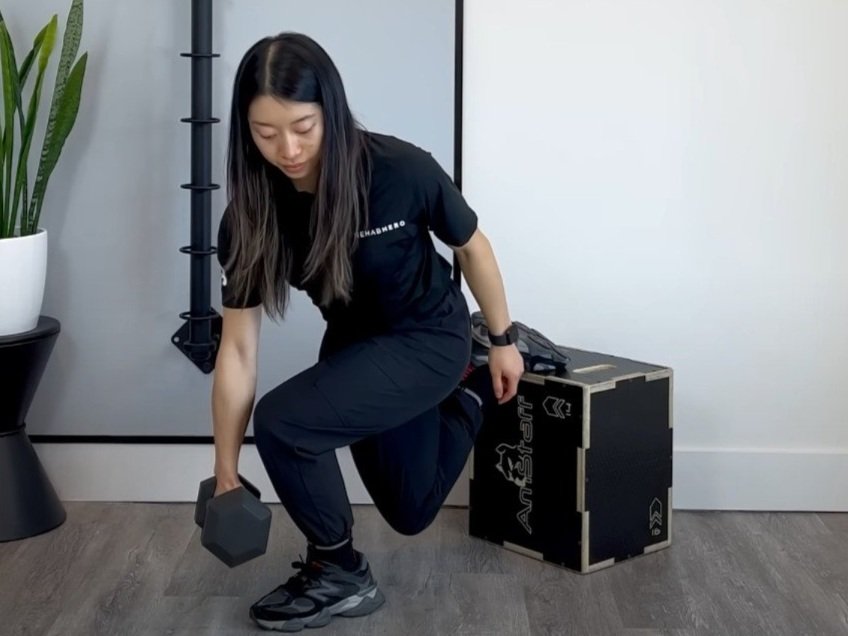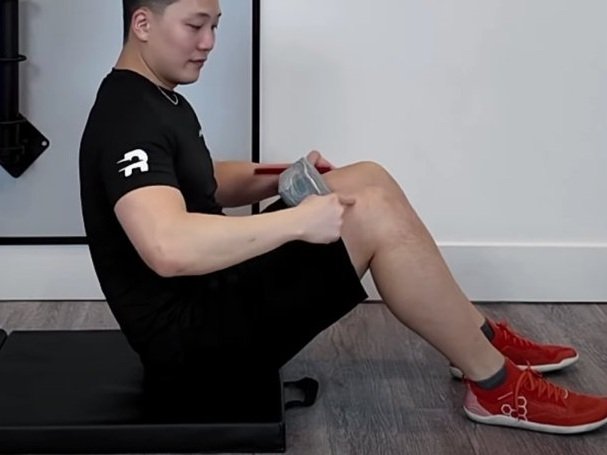Hip Bursitis
Hip Bursitis
Learn about how this hip condition can be causing your pain and how to beat it.
What is bursitis?
Bursitis is a term used to indicate that there is inflammation in a bursa. A bursa is a sac of fluid that is found between layers of soft tissues. Bursa function to decrease friction between rubbing layers of muscles, tendons, ligaments, and bones, and help to allow these connective tissues to glide upon one another freely. However, when they get inflamed, these sacs of fluid can enlarge due to localized swelling and may even generate pain.
Bursa are found in high friction areas throughout the entire body. Again, this is to ensure that you move smoothly and pain free. However, your bursae can get irritate due to repetitive strain, poor biomechanics, muscle contractures, or as a result of an acute injury (like falling onto your hip). Depending on what is causing your bursa to become inflamed, a different plan of management and exercise program may be prescribed by your chiropractor or physiotherapist.
In hip bursitis the bursae found around the hip, namely the greater trochanter, is mostly affected. This condition is considered to be secondary to another condition (often as a compensation mechanism) or due to trauma. this condition is considered to be one of the most causes of hip pain.
Which bursae are affected in hip bursitis?
The most common bursa affected is the trochanteric bursa. It’s due to this that hip bursitis is also known as greater trochanteric pain syndrome, however other bursae may be affected. The other bursa affected include the ischial bursa, iliopsoas bursa, subgluteus minimis bursa, and subgluteus medium bursa.
Who is affected by hip bursitis?
Although this condition can occur to both sexes and at any age, it tends to occur more in females than males, and in those aged 30 to 50 years old. Other risk factors include:
Functional or anatomical leg length inequality
Previous hip, spine, or pelvis injury
Autoimmune diseases such as rheumatoid arthritis or ankylosing spondylitis
Bone spurs / enthesopathy / calcification of tendons
History of local surgery (scar tissue)
What are the signs and symptoms of hip bursitis?
Hip bursitis is described as a dull ache pain that is often felt on the outer aspect of the upper thigh and hip. The pain may refer down the outer leg, and in some circumstances may be felt on the outer shin. Pain is worse with activity, and may be triggered during movements such as going up or down stairs, getting up from a toilet or chair, running, or playing a sport. Pain may be associated with a snapping sensation around the hip and may be associated with a condition called snapping hip syndrome.
Localized point tenderness may be felt and is considered to be a hallmark sign of hip bursitis. Muscles surrounding the hip may be described as tight, these muscles include the gluteus minimus, gluteus medius, gluteus maximus, iliopsoas, and tensor fascia latae (TFL). Pain is worse with external rotation and can be triggered during muscle testing of the aforementioned muscles.
Depending on which bursa is affected, different movements may trigger pain:
Resisted hip abduction is indicative of trochanteric bursitis.
Resisted hip flexion is indicative of iliopsoas bursitis
Resisted hip extension is indicative of ishiogluteal bursitis
Poor biomechanics
Hip bursitis is a secondary injury which means that it is the result of another dysfunction or injury. One of these reasons is due to inefficient or suboptimal biomechanical loading of the lower limb. In cases where poor biomechanics are involved, correction of the movement patterns can bring immediate relief during physical activity. In this respect, hip bursitis may be secondary to lower kinetic pain syndrome. Lower kinetic pain syndrome (LKPS) occurs when a cascade of inefficient biomechanical movements occur as the result of insufficient foot strength. In a nutshell, functional over pronation of the medial longitudinal arch of the foot can cause internal rotation of the knee and put the knee into a valgus position. As a result of the valgus knee, the hip may be pulled into coxa vara leading to excessive repetitive strain on the hip abductor muscles (this is due to the high strain associated with eccentric contractions that occurs as the hip abductors are loaded in a stretched position). Although LKPS can occur starting from insufficient strength stemming from the foot, it can also stem from ankle or knee stability issues instead (with the foot being fully functional).
To get a full biomechanical assessment book in with a Rehab Hero clinician by clicking the button below.
Repetitive strain
Repetitive strain refers to the constant overloading of muscular tissues surrounding the greater trochanter. This may occur as a result of poor biomechanics as mentioned above, but can also occur with good biomechanics. In the instance where repetitive strain occurs with healthy movement, it occurs due to poor exercise programming. In this respect, it is an exercise dosage issue. Repetitive strain occurs when frequency of stress placed on your muscles exceeds the ability of your muscles to recover from physical activity. This can occur with low, medium or high intensity exercise. The higher the intensity the exercise, the less frequently it needs to occur in order to cause repetitive strain. An example of this is a powerlifter squatting at near maximal loads 3-4 times a week. A new runner however may experience repetitive strain when running 5 km five days a week.
Repetitive strain can cause hip bursitis as it may impair full muscle function. As a result, inefficient loading of the hip bursae may occur, leading to inflammation and injury. Hip bursitis resulting from repetitive strain will require reprogramming of exercise dose to optimize your recovery. While full rest is not recommended, relative rest from aggravating activities will be recommended by your health care practitioner. Full rest is not recommended as full rest may result in deconditioning of your hip muscles and prolonging recovery. For personalized exercise programming consult one of our Rehab Hero clinicians by clicking the button below.
Muscle contractures
Muscle contractures are muscles that stiffen up as a result of acute injury, repetitive injury, or surgery. As a result, joints that the muscles attach onto lose both passive and active range of motion. This loss of range of motion can negatively affect your biomechanics and lead to repetitive strain or compensation of your hip muscles (as mentioned above). Muscle contractures may also add unnecessary tension onto the hip bursae as they put excessive pressure on these structures.
Muscle contractures can be treated with a combination of massage therapy, myofascial release therapy, and acupuncture. Your healthcare provider may also recommend stretches to target specific muscles depending on which bursa is affected. Here are some examples of basic stretches that may be recommended:
Trochanteric bursitis: Figure 4 Stretch
Iliopsoas bursitis: Couch Stretch
Ishiogluteal bursitis: Active Hamstrings Stretch
For additional exercises to help you on your journey to full recovery, book in with us in Markham or Toronto by clicking this link.
Acute Injury
It goes without saying that acute trauma can cause pain in the hip and trigger hip bursitis. Acute trauma can cause direct inflammation by injuring or damaging the hip bursa. Compensational movements that offload the injury may also cause the development of chronic hip bursitis if movements are not re-trained after the acute stages of healing are completed. Deconditioning of the hip muscles can also cause the development of poor ineffcient biomechanics, and therefore lead to hip bursitis as well. This is one of the reasons why complete rest exceeding 1-2 weeks may not be recommended following an acute injury.
Acute trauma may also lead to scar tissue development. Scar tissue may restrict fluid movement between layers of soft tissues which may cause irritation or inflammation of the hip bursae. In this same manner surgery is considered to be a risk factor for hip bursitis. Surgery in or around the hip can lead to scar tissue development and restrict soft tissue mobility.
Which conditions mimic hip bursitis?
Differential diagnosis is a term used for conditions that may mimic or present similarly to the primary diagnosis. They can be similar in location of pain, character of pain, or mechanism of pain. The following are some differential diagnosis of hip bursitis:
Glute tendinopathy
Meralgia paresthetica
ITB syndrome
Calcific tendinopathy
Hip osteoarthritis
Septic arthritis
Differential diagnosis can be ruled in or out by a healthcare professional. Orthopedic tests used during a physical examination with a chiropractor or physiotherapist can determine which diagnosis you have. Special tests may be requested by your primary care provider depending on your initial assessment findings. To book in with a physiotherapist or chiropractor at Rehab Hero click the book now button below.
Exercises for hip bursitis
Exercises prescribed to you by your physio or chiro will depend on which bursa is affected. For personalized exercises it is always recommended to see a primary care provider. In the meantime feel free to watch the video below to educate yourself on some exercises that can be used for the most common type of hip bursitis - trochanteric bursitis.
Written by: Dr. David Song
Dr. David Song is a chiropractor and content creator in Toronto, Ontario. With a passion in exercise rehabilitation, he aims to empower his patients through high quality education and therapy. You can find him online with his handle @rehabhero























